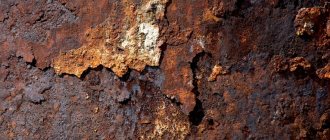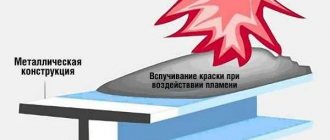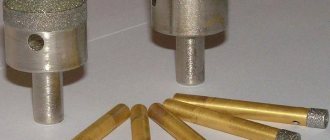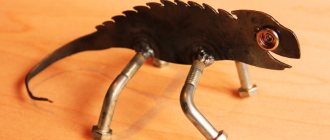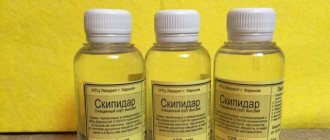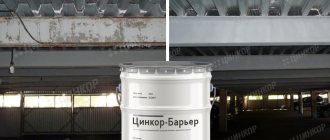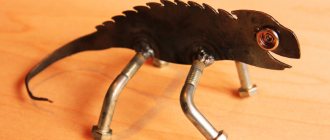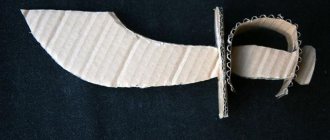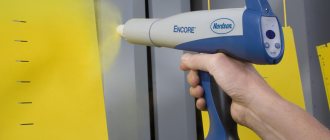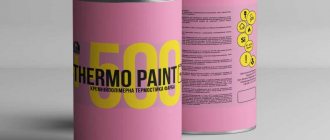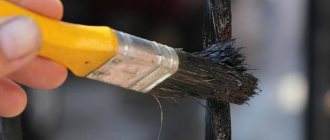There are different ways to treat metal parts to protect them from oxidation and rust formation, and changing the appearance of surfaces. Rubber paint for metal is a universal product that allows you to replace all methods of processing the material. It is important to know how to work with it correctly in order to achieve high-quality results.
Applying rubber paint to metal
Purpose
Rubber coating of metal parts is a procedure that is carried out to protect metal surfaces from oxidation and rust formation.
The technology is used to cover:
- fences, supporting pillars;
- metal roofing sheets;
- galvanized steel sheets;
- corrugated sheets;
- metal structures made of thin sheet steel;
- car body parts, industrial equipment;
- metal parts in places with high humidity levels.
Metal roof
Characteristics
Compound:
- Coalescent. Needed to form a solid film.
- Acrylate latex. Necessary to give elasticity and strength.
- Water. Solvent for coloring composition.
- Antifreeze. Increases the frost resistance of the finished coating.
- Various additives to change the basic characteristics, pigments, fillers.
- Preservative. Needed to preserve the coloring composition during storage.
Characteristics of rubber paint:
- High adhesion.
- Drying time is up to two hours.
- Resistant to temperature changes within -50–+60°C.
- Brushes and rollers are suitable for application. There are rubber coloring compounds that are available in cans for spraying onto metal surfaces.
- Service life - 10 years.
- Extensibility - up to 400%.
The coloring composition is suitable for application to asbestos cement, ferrous metals, asphalt, galvanized steel, aluminum, corrugated sheets, aerated concrete, wood, gypsum, plastic, concrete.
Areas of use
Gumming of metal is widely used for protective coatings in all industrial fields. This method is used to treat the internal space of containers and reservoirs, and to apply it to columns, centrifuges, pipelines, mixers, and stirrers. Before coating, corners are rounded, shells, chips, and cracks are removed. Rubber sheets are glued with special adhesives to a thoroughly cleaned, degreased surface.
Next comes the vulcanization process. The rubber coating is kept at a temperature of 130ºС for 15…25 hours. Vulcanize in autoclaves with water vapor at a pressure of 2.5...3 atm. The internal surfaces of large units are vulcanized with hot air or a salt solution at a temperature of 105...110ºС.
Selection principles
To buy high-quality rubber paint, you need to know the selection criteria and study the manufacturers of the coloring composition.
Criteria
Things to consider when purchasing paint:
- appointment;
- availability of a quality certificate;
- best before date;
- consumption per 1 m2.
Even when applying this type of coloring composition in two layers, the consumption remains minimal.
How to determine the quality of paint?
Need to:
- Inspect the packaging of the coloring composition. It should not have any visual damage.
- Read the ingredients. If it contains an antiseptic, such paint is suitable for wood, not metal.
Manufacturers and prices
Manufacturers:
- Dali;
- Rubber Paint;
- Rezolux Universal;
- lasti Dip;
- Super Decor;
- AKTERM.
The average price for 1 liter is 500 rubles.
Advantages and disadvantages
Positive sides:
- No unpleasant odor during application or use.
- High level of adhesion to different types of metals.
- Resistant to moisture.
- Immunity to temperature changes.
- Service life under normal conditions is 10 years.
- Resistance to mechanical stress.
- Anti-slip effect.
- High elasticity.
- Environmentally friendly.
- Dries quickly after spraying or applying with hand tools.
- Vapor permeability.
It is important to follow the rules for applying paint. Any mistake can lead to peeling of the coating.
Painting of metal structures
Rubber paint for metal. How to paint metal correctly.
There are many options for treating metal parts to protect them from external factors that lead to oxidation or rust.
Many people have metal structures in their dachas: roofs, fences, garages, water storage barrels, pipes and much more. Under the influence of external factors, the metal begins to become covered with rust, which destroys the material.
This process occurs especially quickly if the metal object is not painted with protective paint or the paint is old, and therefore the question arises: what paint should I use to paint the metal? How to properly prepare a surface for painting?
It is important to understand that not every paint will adhere to metals, which are non-ferrous: aluminum, lead, copper, zinc and ferrous: alloys, iron, steel and cast iron.
Most metals oxidize due to air and therefore, before painting, it is necessary to prime them with a special anti-corrosion primer so that the paint adheres more reliably to the metal.
For example:
- Oil paints are not resistant to rust and flake, so they are used indoors.
- Acrylics are more resistant to external factors and therefore are used for outdoor work.
- Enamels contain hazardous solvents that are harmful to health and are quickly destroyed by significant fluctuations in ambient temperature.
- Epoxy is very expensive and is not used for interior work due to its high toxicity. Although they tolerate high temperatures well and do not fade.
Based on extensive experience in the production of paint and varnish products and positive feedback from our customers, we recommend Super Décor rubber paint for metal, which consists of 50% high-quality Finnish latex and tinted with Italian pimentos.
Properties of rubber paint:
- Increased wear resistance to increased physical stress due to high-strength latex polymer and therefore does not rub off.
- Highly elastic: after painting, a latex coating is formed that is capable of stretching and contracting when exposed to external factors. For example: if you paint a sheet of galvanized metal, then after drying it can be bent, scratched, and the polymer will not crack.
- Increased adhesion “sticking” to the metal surface is achieved thanks to the membrane-latex composition and therefore, with strong physical impact, it is impossible to remove the paint. High adhesion - this allows you to ideally apply uniform layers on vertical and horizontal surfaces, ramps, fences and even mesh.
- Environmental friendliness is achieved through safe polymer components and the absence of harmful solvents. It is used for external and internal work in food, medical and children's institutions. Has no odor when applied.
- Has all fire safety certificates. Does not burn when exposed to direct flame.
- Washable with detergents and withstands constant exposure to moisture. Often used as waterproofing for metal roofs.
- A matte, anti-slip coating is formed two hours after application.
- Vapor permeable: capable of allowing air to pass through itself through a membrane-latex structure.
- Heat-resistant to constant changes in air temperature from minus 50 to plus 120 degrees.
- Highly covering: one kilogram can paint about 5-7 square meters.
- Elongation up to 200%, which allows the painted surface not to tear when the metal expands or contracts under the influence of low or high temperatures.
- The drying time after application under normal conditions is at least 2 hours.
- Various tools are suitable for the processing process in the form of a brush, roller or small spray gun with a good paint supply setting and uniform spraying.
- The service life of the applied protective coating is more than 15 years.
Taken together, all of the above properties of latex paint protect your structures made of ferrous and non-ferrous metals from corrosion (destruction) for 15 years and, in addition, give them a beautiful appearance.
What are the disadvantages:
- A matte finish is formed; to achieve a glossy shade it will be necessary to coat it with a glossy varnish.
- All painting work and paint storage must be carried out at temperatures above +3 degrees.
- If you paint a metal pool, latex paint will only last 1-2 years because of the constant exposure to water.
- We recommend not painting the pools, but covering them with a special film or finishing them with plastic and tiles, which is much more expensive than painting and takes a lot of time and effort.
Purpose of paint:
Processing of such parts is a procedure that is necessary to protect the product from oxidation or rust.
Most often, coloring is performed at home and in production for the following structures:
- fences, supporting pillars:
- sheets used for metal roofing;
- metal structures made of thin sheet steel;
- parts that are used in places where there is a high level of humidity.
Rubber paint for metal includes the following components:
- Coalescens. Serves to create a solid film
- Acrylate latex. Needed to create elasticity and strength
- Water. Acts as a solvent for the coloring composition
- Antifreeze. Protects the coating from sub-zero temperatures
- Additives that change the basic characteristics, pigments, fillers
- Preservative. Maintains the homogeneity of the composition during storage.
How to choose the right rubber paint for metal
- To purchase this building material of excellent quality, you should pay attention to the criteria and study the coloring composition.
- In order for a metal fence, structure or product to remain in its original form and have a respectable appearance, it is necessary to give preference to special paint, like Super Decor. It not only has good performance indicators, but is also economical when painting, that is, its consumption per 1 square meter. is 200g.
- The protective layer lays down smoothly and does not spread. It is best to work with it at positive temperatures. You should also avoid performing painting work during heavy precipitation or temperatures above +25 degrees.
Consumption:
On smooth metal surfaces it is 150 grams per square meter. m. in one layer, and 200 grams per corrugated surface.
Color selection:
There are more than 5,000 colors that can be selected according to classic color lines: Tikkurila, NCS, Ral, Dulux and others. These palettes will help you choose the right shade for your interior.
Also colors, if you want to create your own new shade, you can mix different colors with each other until you get the desired color.
Principles of work performance:
When using, you should follow some rules and features, ranging from preparation, putty, processing, coating with a coloring composition.
Tools and materials:
- Calculate the required amount of paint to complete the work.
- Buy rollers or brushes that are of high quality, meaning that the pile will not stick to the painted surface.
- A special painting tray so that you can roll the roller or shake the brush.
- Scotch tape to protect other surfaces that come into contact with the work surface.
- Solvent for removing paint if it gets on other objects.
- A primer for metal, which is mandatory to apply before painting.
- A brush, a grinder - these items are necessary for cleaning products from burrs, shells, chips and roughness.
Application algorithm:
- Prepare the necessary construction equipment: brushes and rollers of different sizes, a bucket, a tray, a construction knife, protective film, masking tape, glasses, a protective suit, gloves, rags and a container of water.
- Old peeling paint or rust should be cleaned with a wire brush and sanded with sandpaper. To speed up the work, we recommend using a grinding machine with various attachments.
- We wash off old dirt with a soap solution, but it is better to use a Karcher-type washing unit, which, due to a jet of water under high pressure, quickly and efficiently washes away various contaminants.
- We degrease the metal using a solvent (for example: white spirit, acetone and others); wiping the surface with a rag. This achieves the dissolution of fatty deposits that cannot be removed with water and chemical cleaning agents.
- We putty metal in the presence of deep cracks and deformations to make the surface smooth and protected from corrosion. Each metal needs its own putty: polyester, nitro putty, epoxy, pentaphthalic and others.
- We apply putty in two thin layers: an intermediate and a finishing layer to avoid shrinkage. The drying period for each layer is about 10 hours.
- Priming is one of the most important stages in preparing metal parts before painting. Consists of the following processes.
- Before priming, be sure to treat the product with a special anti-corrosion compound, which will not allow it to oxidize under the influence of moisture, steam, or sudden temperature changes. Apply the recommended sealing primer for this type of rubber metal paint.
- We carry out priming with a special primer that is suitable specifically for this metal: for priming rust and ferrous metals we use GF-021 primer, which transforms rust and creates a protective film, as a result the paint adheres better and lasts longer on the structure. Each metal has its own primer.
- The primer can be applied with a brush, roller or spray gun with a 1.7 mm nozzle. Consumption per square meter is about 10 grams. Drying time is one hour and the paint can be applied immediately.
- Mix the paint using a construction mixer or a drill with a special attachment for two minutes. We recommend applying the first layer in a thin layer from top to bottom, avoiding smudges. Use a brush to paint hard-to-reach areas, and use a roller for wide areas. Can be applied using an airless spray gun with a 2 mm nozzle, which makes work quicker and easier. Drying time is 10 hours.
- Apply the second layer the next day, in good sunny weather, in the same sequence. The approximate consumption will be 150 grams per square meter in one layer.
- We rinse the brushes, rollers and spray gun under running water for further use of the tools. Only after seven days can you wash the painted metal object, when complete adhesion has occurred.
The metal tiles are painted with Super Decor Rubber paint, color No. 6 Arabica
Painting works
Rubber paint must be used under certain conditions:
- It should not be applied to parts in strong winds, otherwise the layer will be unevenly distributed over the entire surface of the metal.
- It is dangerous to apply the coloring composition in direct sunlight, because in this case, strong evaporation of the paint, which contains chemically active components, occurs.
- The most acceptable temperature for using metal paint is in the range from 5 to 25 degrees, and the permissible humidity level is no more than 70%.
Carrying out work:
- The material must be applied in several thin layers. The difference in application between the previous staining should be at least 4 hours.
- Stir the paint so that it does not thicken
- When performing painting work, it is necessary to take into account the time it takes to fill uneven metal surfaces that cannot be eliminated mechanically. This refers to turns, bends or spot welds. It is best to place tools in a jar of water so that they do not dry out in the open air.
Safety precautions:
It is worth remembering that rubber paint does not contain harmful substances, but for work it is recommended to use hand protection, as well as clothing with long sleeves. If the room is well ventilated, you will not need a respirator or goggles.
Recommendations:
Things to remember when using rubber paint:
1. You cannot use compounds that have expired.
2. For painting, it is best to use a spray gun.
3. It is recommended to wash products after 7 days.
Conclusion:
- Buy rubber paint from the manufacturer to get a quality product at factory prices and a fifteen-year warranty.
- Be sure to read the instructions for use, which are on each can, to avoid mistakes, because each type of paint has its own storage conditions and application rules.
- Carry out all work in dry, sunny weather with low humidity. Do not store jars at temperatures below zero degrees.
- Read customer reviews and advice from construction experts.
- Carefully prepare the surface for painting: clean, degrease, putty, prime and apply the paint correctly to ensure reliable adhesion.
- To save money, do the painting yourself.
#paintformetal
Principles of coloring
When working with rubber paint, it is important to follow a number of rules and features. They relate to preparation, putty, priming of surfaces, and application of paint.
Tools and materials
You need to prepare:
- paint;
- brushes, roller;
- tray for pouring coloring composition;
- thick plastic film, tape, sharp knife or scissors;
- solvent, metal primer;
- metal brush, grinder.
Preparation
Stages of preparation of metal surfaces:
- Remove any dirt or deposits with sandpaper, a metal brush or a grinder.
- Degrease surfaces with solvent or detergent. It is important to remove all stains.
- Wait until the surfaces are completely dry.
Puttying
Puttying is carried out when there are large damages and cracks on the surfaces. Before continuing to prepare the part, you need to coat it with a special filler and wait for it to dry.
Padding
Another important step in preparing metal surfaces before painting is priming. Primer application process:
- Before covering metal surfaces with a primer, you need to apply a special anti-corrosion compound to them.
- Apply an inhibitory or isolating primer.
Wait for it to dry. Treat glossy surfaces with fine sandpaper to increase adhesion, sweep away any dust that appears.
Applying crumb rubber
Above we talked about the characteristics and use, about spraying rubber in liquid form, and now we’ll talk a little about spraying crumb rubber. This type of coating appeared relatively recently, about 10 years ago, and if installed correctly can last for a long time.
When using such a material, a sealed surface is created, evenly distributed throughout the solid base.
This application has many advantages:
- The surface is absolutely non-slip; it forms an excellent bond with the soles of shoes and car tires, as a grainy texture is created.
- Long service life.
- Low consumption of the composition; when creating a rubber layer, a thickness of 3-30 millimeters is formed.
- The layer is continuous and without seams.
Recommendations
Tips for working with rubber paint:
- Do not use formulations that have expired.
- For painting it is better to use a spray gun. Using this tool, you can achieve a uniform distribution of the paint layer.
- Painted surfaces can only be washed after 7 days.
It is important to properly clean work surfaces to achieve a high level of adhesion.
Rubber paint is a universal composition that is suitable for processing different materials. When using it, you can achieve an anti-slip effect, protection against oxidation, rust formation, and leveling of the sides. It is important to take into account the features of applying the coloring composition.
Rubber coating
Liquid rubber spraying is a technological process using special equipment that allows you to solve even the most difficult problems associated with ensuring the protection of numerous objects in various spheres of human life (construction, mining, railway and automotive industries, utilities, environmental protection, agriculture and marine industries, etc.) etc.).
You can make a protective coating with the presented material by ordering a service from specialized organizations or providing protection for your needs yourself. To give a more aesthetic appearance and additional protection, you can apply decorative paint specially designed for this material to the resulting surface.
Advantages of using rubber material for protecting surfaces:
- quick painting and perfect processing of the most complex terrain, envelops all corners, protrusions, bends around pipes, wires and drains;
- has a long service life;
- does not require frequent repairs, but if necessary, it can easily be corrected and does not require large expenses for corrections, since only the area that has been damaged is repaired;
- no leaks occur during installation;
- the paint firmly adheres to any surface (concrete, metal, brick, wood);
- 100% impermeability, since all cracks and pores in the coated base are filled;
- complete protection against chemical and water corrosion, resistance to ultraviolet radiation;
- complete absence of seams and joints;
- does not emit toxic substances, completely safe paint;
- resistance to any punctures and cuts;
- the equipment used to apply the material is easy to use.
Rubber coating is convenient, practical, beautiful, safe and durable.
How to do the work yourself
It was said above that it is possible to carry out such a process yourself, because small areas of surfaces do not require particularly special skills, and applying rubber material is not difficult, the main thing is diligence and having the appropriate equipment. Let's consider this process using the example of a roof. In order to carry out the work correctly, first you need to correctly calculate everything, because to lay rubber paint it is necessary to take into account the load that the roof can withstand, so for this the following indicators are calculated:
- To paint one square meter with a thickness of 1 mm, you need to use approximately 1.5 liters of rubber compound.
- To seal cracks, pores, seams and protect a metal roof from corrosion, you need to apply a layer of the composition of at least 1.5 mm.
- To insulate wooden structures from water, it is optimal to lay a layer of material 1.5 mm thick.
- For membrane roofing, you need to apply rubber material with a thickness of at least 2 mm, but it is best to lay it at 3 mm.
- To protect concrete or reinforced concrete surfaces from corrosion, you need to lay a layer of the composition of at least 3 mm.
Now we are preparing special equipment for applying the rubber compound. For this purpose, a specialized apparatus is used that operates without air. It is considered universal and runs on gasoline or electricity. The main condition is to thoroughly prepare the surface, clean it of dirt and debris. With paint application technology, all defects, cracks and pores are filled with the applied material.
So, we begin to spray the composition using the prepared equipment. This type of painting is a mechanical method and is applied to a clean surface using equipment connected to a vessel containing a polymer-bitumen emulsion and to a tank containing a hardener with calcium chloride. These two components, mixed in a nozzle, are applied to the surface, resulting in a bitumen-polymer layer of the required thickness. (2-4 mm). As you can see, it is not at all difficult to carry out such a process, the main thing is to have the necessary equipment and desire.
Spraying requires special equipment
